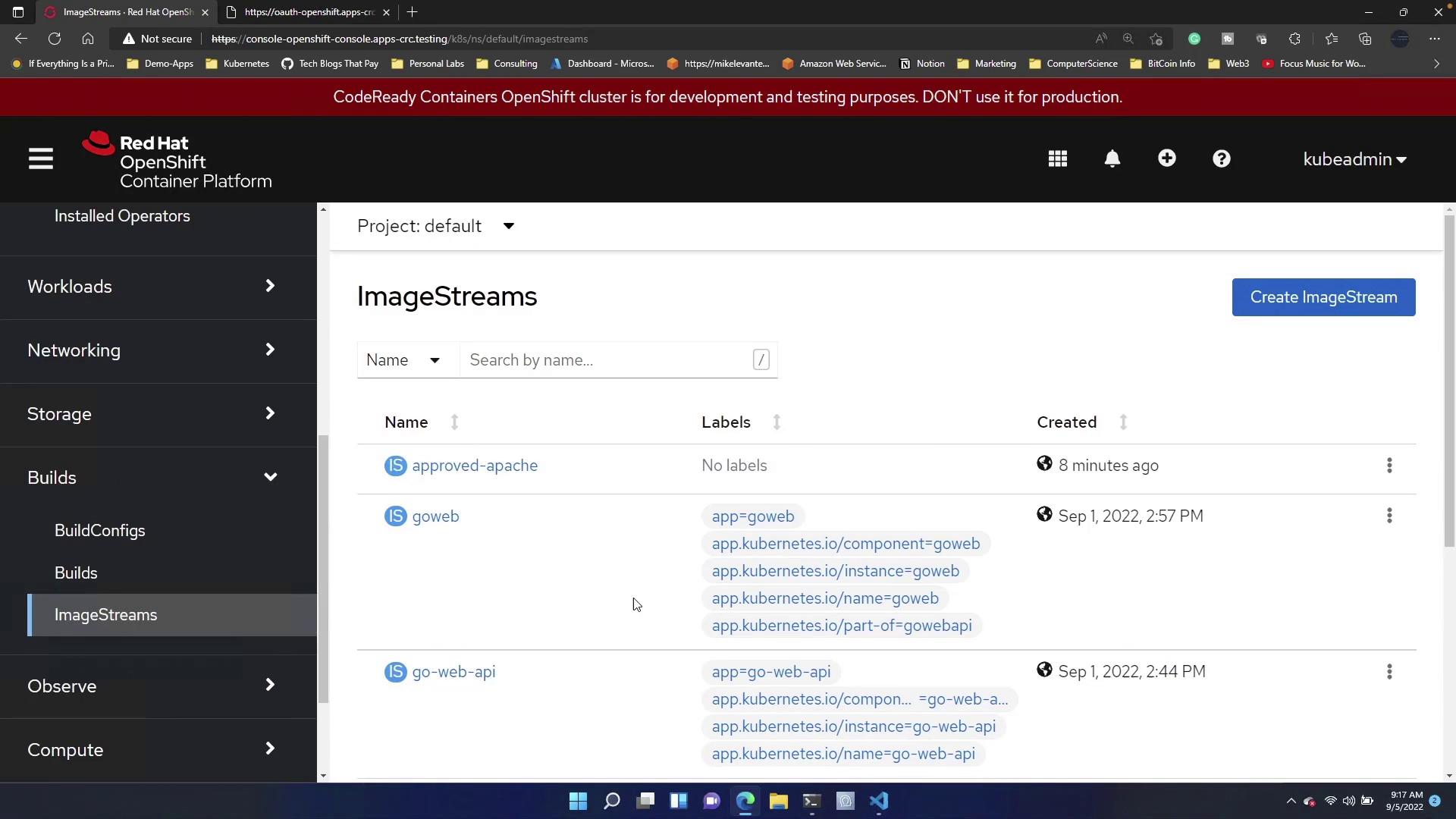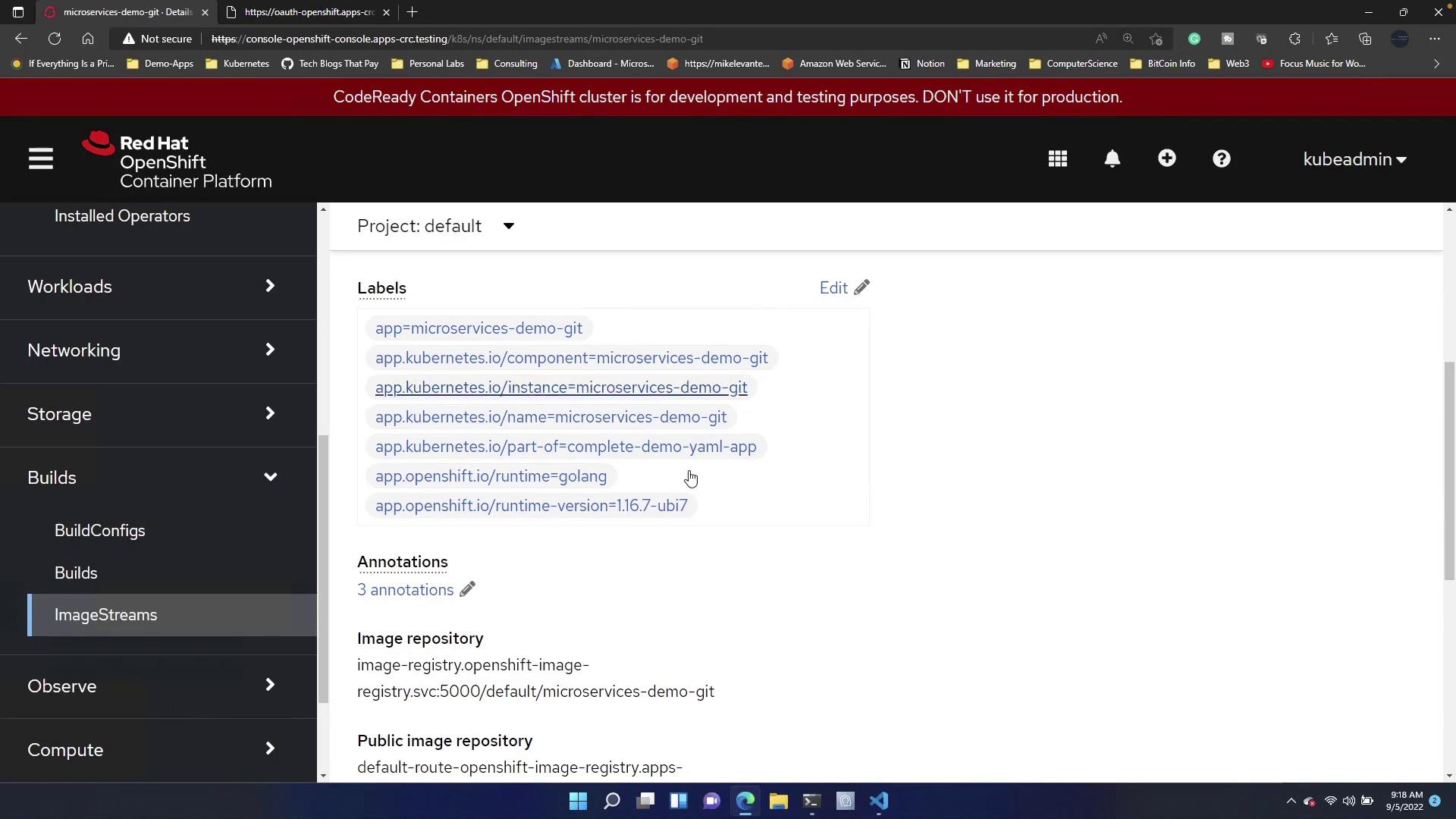OpenShift 4
Concepts Builds and Deployments
Demo Image Streams
In this guide, we walk through creating and deploying an ImageStream in OpenShift. ImageStreams are essential in OpenShift as they help manage container images and their tags, streamlining your deployment workflow.
Navigating the OpenShift Console
First, open the OpenShift console and navigate to the Builds section, then select ImageStreams. You will notice that many deployments already have their own ImageStreams.

Next, by clicking on "Microservice Demo Git," you can inspect the SockShop application that was previously deployed. This application already has an associated ImageStream.

Creating a New ImageStream for the Carts App
Suppose you want to create a new ImageStream for a specific deployment within SockShop, such as the Carts app. To do this, click on the "Create ImageStream" option. Remove any undesired default content and paste the following configuration:
kind: ImageStream
metadata:
name: carts
spec:
lookupPolicy:
local: false
tags:
- name: "0.4.8"
from:
kind: DockerImage
name: weaveworksdemos/carts:0.4.8
referencePolicy:
type: Source
This YAML configuration sets up an ImageStream for the Carts app using the tag "0.4.8," which is sourced from the specified Docker image.
Note
ImageStreams help you manage different versions of container images efficiently, ensuring consistency across your deployments.
Inspecting the Deployment Manifest
If you are curious about the underlying container image configuration, you can examine the deployment manifest in an editor such as VS Code. Here is the deployment configuration for the Carts app:
apiVersion: apps/v1
kind: Deployment
metadata:
name: carts
labels:
name: carts
spec:
replicas: 1
selector:
matchLabels:
name: carts
template:
metadata:
labels:
name: carts
spec:
containers:
- name: carts
image: weaveworksdemos/carts:0.4.8
ports:
- containerPort: 80
Deploying the Application Using the ImageStream
Once the ImageStream is in place, you can deploy an application based on it. Open your terminal and execute the command below to deploy the Carts app from the "default" project:
oc new-app --image-stream=default/carts:0.4.8
At this point, you might receive output similar to the example below, indicating that the deployment already exists:
oc new-app --image-stream=default/carts:0.4.8
--> Found image c004737 (5 years old) in image stream "default/carts" under tag "0.4.8" for "default/t/carts:0.4.8"
--> Creating resources ...
error: deployments.apps "carts" already exists
--> Failed
mlevan@littleship01 ~ [] Desktop microservices-demo-openshift 🡆 master ≡ 0 ?1 🡆
oc
Warning
An error indicating that the deployment already exists means that a previous deployment is conflicting with the new one.
Resolving Deployment Conflicts
To resolve this issue, delete the existing deployment by running:
oc delete deployment carts
After confirming the deletion, verify the list of remaining deployments with:
oc get deployments
NAME READY UP-TO-DATE AVAILABLE AGE
approved-apache 1/1 1 1 8m29s
carts 1/1 1 1 3m2s
catalogue 1/1 1 1 3d18h
catalogue-db 1/1 1 1 3d18h
front-end 1/1 1 1 3d18h
goweb 1/1 1 1 3d18h
mongodb 0/1 1 0 5m36s
nginx-deployment 2/2 2 1 3d18h
orders 1/1 1 1 3d18h
orders-db 1/1 1 1 3d18h
payment 1/1 1 1 3d18h
queue-master 1/1 1 1 3d18h
rabbitmq 1/1 1 1 3d18h
shipping 1/1 1 1 3d18h
user 1/1 1 1 3d18h
user-db 1/1 1 1 3d18h
Now, run the deployment command again:
oc new-app --image-stream=default/carts:0.4.8
--> Found image c004737 (5 years old) in image stream "default/carts" under tag "0.4.8" for "default/t/carts:0.4.8"
--> Creating resources ...
deployment.apps "carts" created
--> Success
Run 'oc status' to view your app.
mlevan@littleship01 ~/Desktop/microservices-demo-openshift (master) $
To confirm that the Carts app is now running, execute:
oc get deployments
NAME READY UP-TO-DATE AVAILABLE AGE
approved-apache 1/1 1 1 8m58s
carts 1/1 1 1 8s
catalogue 1/1 1 1 3d18h
catalogue-db 1/1 1 1 3d18h
front-end 1/1 1 1 3d18h
goweb 1/1 1 1 3d18h
mongodb 0/1 1 0 6m5s
nginx-deployment 2/2 2 2 3d18h
orders 1/1 1 1 3d18h
orders-db 1/1 1 1 3d18h
payment 1/1 1 1 3d18h
queue-master 1/1 1 1 3d18h
rabbitmq 1/1 1 1 3d18h
shipping 1/1 1 1 3d18h
user 1/1 1 1 3d18h
user-db 1/1 1 1 3d18h
With these steps, the new ImageStream for the Carts app has been successfully deployed. This method allows you to target and deploy individual microservices using ImageStreams in OpenShift, thereby simplifying application management in a containerized environment.
Watch Video
Watch video content